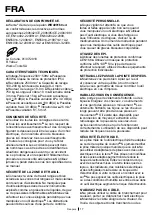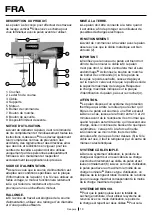
4
English
ENG
1. Hook.
2. End race lever.
3. Cable.
4. Supports.
5. Motor.
6. Control.
7. Switch.
8. Safety button.
9. Download limit device.
USE INSTRUCTIONS.
►
Before starting up the hoist, we recommend
that you carefully read all of the instructions as
indicated
►
Please respect all regulations regarding
the prevention of accidents, health and safety
directives, laws and applicable restrictions for work
places
►
The hoist must only be used by persons
who have been instructed in its use and only for the
purposes for which it has been designed.
POWER SUPPLY.
►
Make sure the power supply is adapted to the
requirements shown on the information panel of the
hoist (1)
►
Using the motor at low voltage will make
it operate slowly
►
This will reduce performance
and may cause the motor to overheat.
EXTENSION CORD.
►
If the working area is at some distance from the
power supply, use an extension cord of enough
diameter and quality.
EARTH CONNECTION.
►
The hoist must be connected to earth while
being used to protect the operator from possible
electrical shocks.
OPERATION.
►
Before starting the work, make sure that the
steel cable is correctly winded around the reel (2).
CAUTION.
►
Check that the hoist is levelled for proper cable
winding
►
If the hoist is not levelled, the cable will
get wrapped and damaged
►
Drive the switch of
the control (3)
►
In case the hoist cannot hoist a
load, do not keep pressing the switch, this means
that the load exceeds the hoist maximum capacity
►
Observe the maximum load indicated in the
information panel of the hoist, not on the hook (4).
WARNING.
►
If the hoist is subjected to an excessive effort,
it has a thermal protection system that stops
the engine to prevent burning
►
In this case you
should allow to cool 10 to 20 minutes before using
it again
►
If the hoist stops during the lowering of
a load, it is normal that the load goes down a few
centimeters more because of inertia
►
Leave at
least three turns of cable around the reel, so that
the cable connection is not under stress (5)
►
If the
steel cable is worn out, it must be replaced only
with a cable of same features.
SIMPLE CABLE SYSTEM.
►
In this modality of use the weight of the load
rests on a single cable
►
The load enlists directly
to the cable of the hoist and it rises with normality
(6)
►
Using this way of use, the hoist has capacity
to at the most elevate half of its rated load
►
In this
type of use, it is available the total of the length of
the cable of the coil to elevate as limit half of the
fully factored load of the hoist.
FORWARD SYSTEM.
►
The way of which the hoist can elevate the total
of its rated load is using the forward system
►
In
this modality of use the weight of the load rests on
two cables
►
For it, it removes sufficient cable from
the coil and fixes the hook to the orifice located in
the frontal part of the housing of the hoist (7)
►
This
way, the load to the high being has two support
points, by a side the own cable coil and on the other
hand the hook fixed on the housing
►
Place on the
cable the provided pulley (8)
►
This pulley will be
the hold point of the load in the forward system
►
Remember that to elevate the total of rated load
of the hoist the forward system has to be used
necessarily
►
In this type of use, it is available half
of the length of the cable of the coil to elevate as
limit the total of the fully factored load of the hoist.
FIXATION TO A SUPPORT.
►
The hoist has four orifices in the upper part of
the housing (9)
►
You can use these four orifices
like anchorage points if it is going to fix the hoist
to a metallic plate or something similar using the
screws provided for it
►
In the same way, two
clips are provided to fix them to the housing of
the hoist and by the way fix it safely to a suitable
support (10)
►
It is extremely important verifying
that all the screws are perfectly tightened and
that the fixation is completely safe.




































